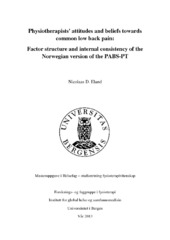Physiotherapists' attitudes and beliefs towards common low back pain: Factor structure and internal consistency of the Norwegian version of the PABS-PT
Master thesis
Permanent lenke
https://hdl.handle.net/1956/7949Utgivelsesdato
2013-08-05Metadata
Vis full innførselSamlinger
Sammendrag
Background: The Pain Attitudes and Beliefs Scale for Physiotherapists (PABS-PT) is a self-administrated questionnaire designed to discriminate between a biomedical and a biopsychosocial treatment orientation of therapists with regard to low back pain management. Aim: The aim of this study was to translate the PABS-PT into Norwegian from the original 36-item Dutch version, and to examine its dimensionality and internal consistency. Methods: The Norwegian version was generated in a forward- backward translation procedure. A cross-sectional web-based survey was conducted. A convenience sample of 3.849 physiotherapists was invited to fill out demographic and professional data and the PABS-PT. Therapists who had not been involved in back pain management for the last 6 months were excluded. Descriptive statistics was used to describe demographic data. Principal factor analysis and reliability analysis was performed to determine the factor structure and internal consistency. Results: The PABS-PT was successfully translated into Norwegian. Responses from 921 therapists were obtained (response rate 24.8 %). 774 therapists completed the questionnaire of which 647 were included in factor analysis. Principal factor analysis confirmed the two-factor structure of the original Dutch version. Thirty-six items were reduced to 19, with 13 items in factor I and 6 items in factor II. Internal consistency (Cronbach's alpha) of the biomedical subscale amounted to 0.79 while alpha of the biopsychosocial subscale amounted to 0.57, explaining 18.1 % and 7.1 % respectively, of the total variance. Conclusion: The results of this research project provide evidence supporting the internal structure and internal consistency of the Norwegian version of the PABS-PT. More research is needed to further examine the questionnaire's psychometric properties and usefulness. Bakgrunn: Pain Attitudes and Beliefs Scale for Physiotherapists (PABS-PT) er et selv-rapportert spørreskjema som er utviklet for å skjelne mellom en biomedisinsk og en biopsychososial behandlingsorientering relatert til behandling av korsryggsmerter blant fysioterapeuter. Hensikt: Hensikten med studien er å oversette PABS-PT til norsk fra den originale nederlandske versjonen med 36 spørsmål, og å undersøke dets dimensjonalitet og interne konsistens. Metode: Den norske versjonen ble oversatt i en oversettelses-tilbakeoversettelsesprosess. En internett-basert spørreundersøkelse med tverrsnittdesign ble gjennomført. Et bekvemmelighetsutvalg av 3.849 fysioterapeuter ble invitert til å fylle ut demografiske og profesjonelle data, samt PABS-PT. Terapeuter som ikke hadde behandlet pasienter med korsryggsmerter de siste 6 måneder, ble ekskludert. Deskriptiv statistikk ble brukt for å beskrive de demografiske dataene. Prinsipal faktoranalyse og reliabilitetsanalyse ble gjennomført for å bestemme faktorstrukturen og intern konsistens. Resultater: Oversettelsen av PABS-PT til norsk var vellykket. Svar fra 921 terapeuter ble innsamlet (svarprosent 24.8 %), 774 terapeuter fylte ut spørreskjemaet, hvorav 647 ble inkludert i faktor analysen. Prinsipal faktoranalyse bekreftet to-faktorstrukturen til den originale nederlandske versjonen. De 36 spørsmålene ble redusert til 19, med 13 spørsmål i faktor I og 6 spørsmål i faktor II. Intern konsistens (Cronbach's alpha) til den biomedisinske subskala kom opp i 0.79, mens alpha til den biopsychososiale subskala kom opp i 0.57, som forklarte henholdsvis 18.1 % og 7.1 % av den totale variansen. Konklusjon: Resultatene av dette forskningsprosjektet skaffer evidens for intern struktur og intern konsistens til den norske versjonen av PABS-PT. Mer forskning er nødvendig for videre undersøkelse av spørreskjemaets psychometriske egenskaper og egnethet.
